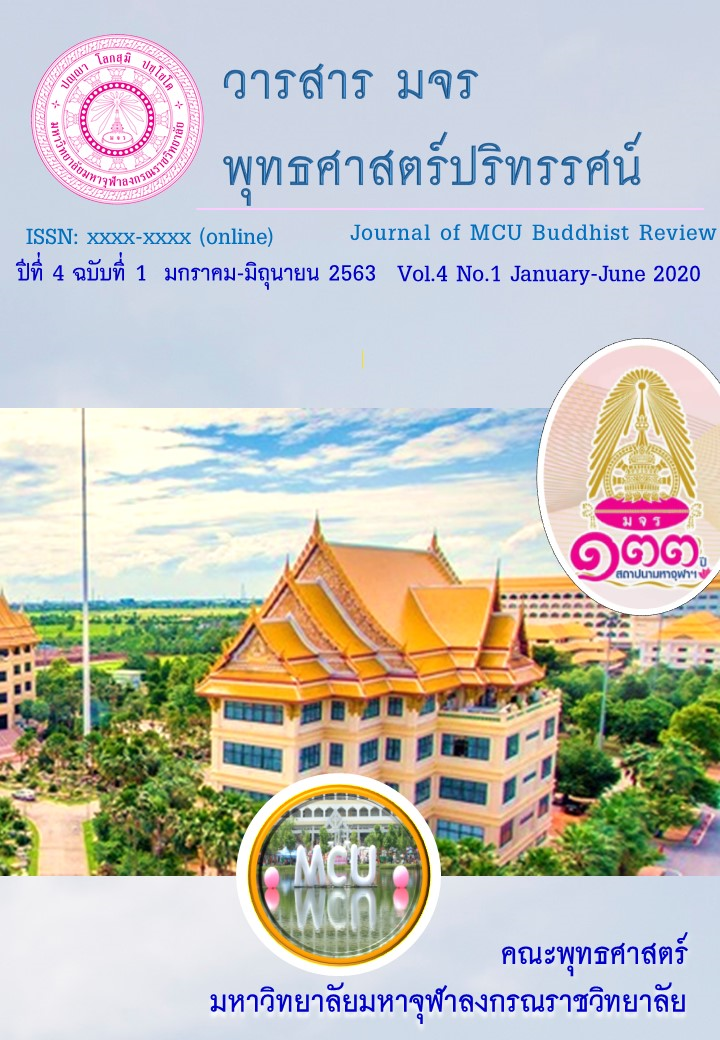ศีลในพรหมชาลสูตร : ศีลเพื่อชีวิตที่งดงาม
Main Article Content
บทคัดย่อ
งานวิจัยนี้ผู้วิจัยมุ่งที่จะศึกษาเรื่อง ศีลในพรหมชาลสูตร : ศีลเพื่อชีวิตที่งดงาม ซึ่งมี วัตถุประสงค์ ๒ ประการ คือ ๑) เพื่อศึกษาศีลที่ปรากฏในพรหมชาลสูตร ๒) เพื่อศึกษาหลักธรรมที่ปรากฏในพรหมชาลสูตร ระเบียบวิธีวิจัยที่เลือกใช้เป็นการวิจัยเชิงเอกสาร โดยใช้วิธีการวิเคราะห์เชิงพรรณนา
ผลการศึกษาพบว่า พรหมชาลสูตรเป็นพระสูตรที่เน้นเรื่องศีล สมาธิ ปัญญาที่ระบุถึงความหลากหลายทางความคิดด้านศาสนาที่ลึกซึ้ง โดยเฉพาะการกล่าวถึงศีลอันเป็นข้อปฏิบัติเบื้องต้นของการเป็นสมณะที่ดีในยุคสมัยพุทธกาลที่มีการนำเอาศีลมาเป็นข้อโต้แย้งทางความคิดและการปฏิบัติ ซึ่งพระพุทธองค์ทรงแสดงเรื่องศีลไว้ในพระสูตรนี้ในช่วงต้นของสมัยพุทธกาล กล่าวคือ จุลศีล มัชฌิมศีล และมหาศีล ซึ่งเป็นศีลที่พระพุทธองค์ทรงยอมรับว่า มีความงดงามและสอดคล้องกับหลักมัชฌิมาปฏิปทา โดยทรงแสดงศีลที่เป็นข้อห้ามมากกว่าศีลที่เป็นข้ออนุญาตว่า พระพุทธองค์หรือภิกษุสงฆ์ในพระพุทธศาสนาจะทรงเลือกเอาศีลระดับใดมาประพฤตินั้น มีแนวทางในการปฏิบัติดังนี้ (๑) จุลศีล เป็นข้อปฏิบัติเบื้องต้นสำหรับผู้เริ่มปฏิบัติหรือผู้ที่เพิ่งเข้าถือบวช (๒) มัชฌิมศีล เป็นข้อปฏิบัติสำหรับผู้ที่ปฏิบัติและพัฒนาตนเองได้ระดับหนึ่งแล้ว (๓) มหาศีล เป็นช้อปฏิบัติสำหรับผู้ที่บรรลุธรรมฃั้นสูงหรือเพื่อถึงนิพพาน ดังนั้นกรอบแนวคิดเรื่องศีลที่ปรากฏในพรหมชาลสูตรนี้ แสดงแนวคิดเรื่องศีลเป็นเบื้องต้นของพระพุทธศาสนาก่อนที่จะมีการบัญญัติพระวินัยอันเนื่องจากความประพฤติผิดของสงฆ์ จากการศึกษาทั้งหมดพบว่า แนวคิดเรื่อง ศีลในพรหมชาลสูตรนั้นให้คุณค่าหลายประการ สามารถปรับใช้ในชีวิตประจำวันโดยเป็นกรอบแนวทางการปฏิบัติสำหรับผู้ที่สนใจเดินตามรอยพระพุทธองค์ได้เป็นอย่างดี
Article Details
- บทความที่ได้รับการตีพิมพ์เป็นลิขสิทธิ์ของวารสาร มจร พุทธศาสตร์ปริทรรศน์
- ข้อความใดๆ ที่ปรากฎในบทความที่ได้รับการตีพิมพ์ในวารสาร ถือเป็นความรับผิดชอบของผู้เขียนบทความ และข้อคิดเห็นนั้นไม่ถือว่าเป็นทัศนะและความรับผิดชอบของกองบรรณาธิการวารสาร มจร พุทธศาสตร์ปริทรรศน์
เอกสารอ้างอิง
พระพรหมคุณาภรณ์ (ป.อ.ปยุตฺโต). (2551). พจนานุกรมพุทธศาสตร์ ฉบับประมวลธรรม. กรุงเทพมหานคร : โรงพิมพ์มหาจุฬาลงกรณราชวิทยาลัย.
มหาจุฬาลงกรณราชวิทยาลัย. (2539). พระไตรปิฎกภาษาไทย ฉบับมหาจุฬาลงกรณราชวิทยาลัย. กรุงเทพมหานคร: โรงพิมพ์ มหาจุฬาลงกรณราชวิทยาลัย.
พระพุทธโฆสะ. (2551). คัมภีร์วิสุทธิมรรค. แปลโดยสมเด็จพระพุฒาจารย์ (อาจ อาสภมหาเถร). พิมพ์ครั้งที่ 7. กรุงเทพมหานคร: ธนาเพรส.


